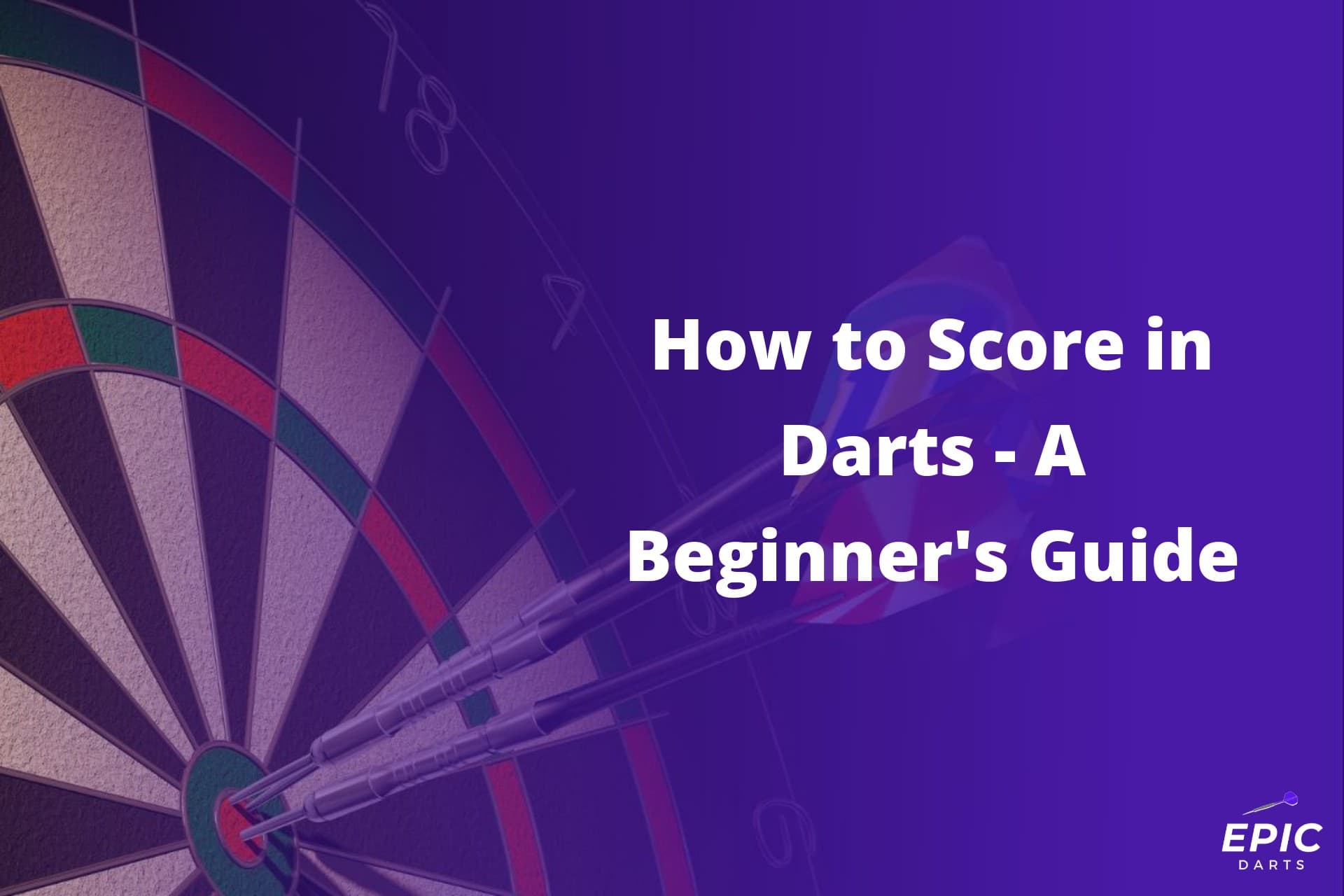Did you know that darts scoring is not just about throwing sharp objects at a board? It’s also about keeping track of your scoresheet, aiming for the wickets, and improving your throwing technique as a skilled thrower. It’s a game of precision, strategy, and accumulating points. Whether you’re a beginner or an experienced player, understanding the basics of darts scoring is essential to your success on the dartboard. Keeping track of your scoresheet and aiming for high scores, hitting the tip of the darts into the wickets, should be your ultimate goal.
Scoring in darts depends on the particular game you’re playing, but in a standard game of 501, the objective is to reduce your score from 501 to zero before your opponent does. Players throw three darts in turn and subtract the total scored from their current total. The trick is that you must reach zero by hitting a double or the bullseye on your final dart. So, for example, if you have 16 points remaining, you would need to hit double 8 to win.
Scoring in darts requires accuracy and careful planning. As a darts player, it is important to follow the rules and work together as a team. When aiming for high-scoring sections on the darts board, be careful to avoid penalties. Playing darts is not just about throwing; it’s about calculating risks and making strategic decisions as a team. Every player must adhere to the rules of the game to ensure fair play.
So, whether you’re aiming for bullseyes with your thumb or trying to avoid busting your score as a player on a team, mastering darts scoring in the thumb section is crucial.
Basic Rules and Scoring System of Darts
Darts is an exciting game that requires precision, skill, and strategy. Whether you’re playing in a friendly match at your local pub or competing in a professional tournament, understanding the basic rules and scoring system is essential to improve your chances of scoring high.
Each player starts with a score of 501 or 301 (depending on the variant being played) and aims to reach zero using as few darts as possible. The dartboard, which is divided into numbered sections, serves as the target for players to aim their throws. Let’s take a closer look at how scoring works in darts.
Scoring Points
Hitting different sections on the dartboard earns varying points based on their values. The board consists of several areas, each with its own point value:
- Bullseye: Located at the center of the board, hitting the bullseye scores either 50 points for the outer ring or 25 points for the inner circle.
- Outer Ring: This area surrounds the bullseye and is divided into two sections – single (worth its face value) and double (worth double its face value). For example, if you hit a single 20 segment in this area, you would score 20 points; however, hitting a double 20 would earn you 40 points.
- Inner Area: The inner area consists of triple segments that are worth three times their face value. If you hit a triple 20 segment here, you would accumulate an impressive 60 points.
- Outer Section: This section includes all other numbered segments on the board that are not part of the bullseye or inner area.
Players subtract their score from the starting total with each throw until they reach zero. It’s important to note that the final dart must land in a double or the bullseye to reach zero and win the game. Otherwise, the player’s score will be “busted,” and they will need to try again on their next turn.
Keeping Score
To keep track of scores during a match, players use a scoresheet or electronic scoring system. The scoresheet typically consists of two columns: one for each player’s current score and another for their remaining score after each round. Players write down their scored points after each throw and subtract them from their previous total.
The game progresses as players take turns throwing three darts per round until one of them reaches zero. It is crucial to strategize your throws wisely, aiming for high-scoring areas while leaving yourself with an opportunity to finish on a double or bullseye.
Understanding Dart Scores and How to Calculate Them
Dart scores are an essential part of the game, as they determine who comes out on top. To become a skilled darts player, it’s crucial to understand how scores are calculated and the various factors that come into play. Let’s delve into the intricacies of dart scoring and learn how to calculate scores accurately.
Calculating Dart Scores
The process of calculating dart scores is relatively straightforward. Players start with a specific number of points, commonly 501 or 301, and aim to reduce their score to zero by hitting different segments on the dartboard. Here’s a breakdown of how it works:
- Subtracting points earned: Each time you throw your darts, you earn a certain number of points based on where they land on the board. To calculate your score after each turn, subtract the total points earned from your remaining score.
- Multipliers: The dartboard features double and triple rings surrounding each segment. If your dart lands in one of these rings, it multiplies the value of that particular segment by either two or three, respectively.
- Bullseye: Hitting the bullseye can significantly impact your score. The inner bullseye grants you 50 points, while hitting the outer bullseye awards 25 points.
By understanding these basic principles, you can begin strategizing for higher scores and faster reductions in overall score.
Aiming for High-Value Segments
To maximize your chances of achieving high scores in darts, targeting high-value segments is key. These segments include:
- Triple 20: Located at the top center of the board, hitting this segment awards 60 points (triple multiplier) –the highest possible score for a single dart.
- Double rings: Targeting double rings can help quickly reduce your overall score since they multiply the value by two.
- High-value areas: Other segments worth considering are triple 19, triple 18, and triple 17, which offer scores of 57, 54, and 51 points respectively.
By focusing on these lucrative areas of the dartboard, you can make significant progress in reducing your score.
Practice Makes Perfect
As with any skill, practice is vital to improving your darts game. The more you play and hone your skills, the better you’ll become at calculating scores accurately and consistently hitting high-value segments. Consider incorporating the following tips into your practice routine:
- Target specific numbers: Choose a specific number to start with (e.g., 170) and aim to reach zero using different combinations of throws. This exercise will help improve your mental math skills and familiarize yourself with various scoring options.
- Play different game variations: Explore different dart games like “Around the Clock” or “Cricket” that require strategic thinking and involve targeting specific numbers or sections of the board. These games provide excellent opportunities for practicing score calculation in a fun way.
- Analyze professional players: Watch professional darts matches to observe how experienced players strategize their throws and calculate their scores effectively. You can learn a lot by studying their techniques and applying them to your own game.
Different Dart Games and Scoring Variations
Darts is a versatile game that offers a wide range of options for players to enjoy. From casual gatherings to professional tournaments, there are various dart games with unique scoring rules that keep the excitement alive. Let’s explore some of these thrilling variations and how they can be played.
Various Dart Games
- 301: In this popular game, each player starts with 301 points and must work their way down to zero by subtracting their scores from the initial total. The objective is to reach exactly zero by hitting doubles or a double bullseye.
- 501: Similar to 301, in 501 players begin with 501 points and aim to reduce their score to zero. However, unlike 301, players have more flexibility in choosing which numbers on the board they want to hit.
- Cricket: Cricket is a strategic game where players aim to close specific numbers on the dartboard while accumulating points along the way. The goal is to close all numbers from 15-20 and the bullseye before your opponent does.
- Around the Clock: This classic game tests accuracy as players attempt to hit every number on the dartboard in sequential order, starting from one and ending at twenty.
Unique Scoring Rules
Each dart game has its own set of scoring rules that add excitement and strategy:
- Some games require hitting specific targets such as certain numbers or closing out segments first.
- Tactics like doubling in (starting with a double) and doubling out (ending with a double) add an extra layer of challenge.
- Certain variations allow players to choose between straight start (starting at any number) or double start (starting at double one) options.
- In some games, hitting triples instead of doubles can provide higher scores or special bonuses.
These scoring variations make each game distinct, catering to different playing styles and preferences.
Engaging Strategies
To excel in dart games, players must employ effective strategies:
- Target Selection: Analyze the game’s scoring rules and choose targets that maximize your points or help you close out numbers faster.
- Precision and Accuracy: Consistent throws with good aim are crucial for achieving high scores and hitting desired targets.
- Game Management: Calculate scores effectively to plan your next moves strategically. Be mindful of your opponent’s progress as well.
- Practice Makes Perfect: Regular practice helps improve throwing technique, accuracy, and overall performance.
Mastering Popular Dart Games and Their Scoring Techniques
Darts is a game that requires precision, skill, strategy, and play. To become a master at darts, it is essential to understand the scoring techniques of popular dart games.
Cricket: Closing Numbers and Preventing Opponents
In Cricket, the objective is to play darts and close numbers on the dartboard while preventing your opponents from doing so. This game requires both offensive and defensive tactics. To score higher in Cricket, focus on closing numbers quickly. Aim for treble 20s or treble 19s to gain an advantage over your opponent. By hitting these high-scoring areas consistently, you not only accumulate points but also deny your opponent the opportunity to do so.
501: Aiming for Treble 20s for Faster Finishes
In 501, players start with a score of 501 and aim to reach zero using as few darts as possible. One effective technique is to target treble 20s consistently. By landing three darts in the treble 20 segment, you instantly score 180 points – the maximum possible in a single turn. This not only boosts your score but also brings you closer to finishing the game faster with fewer darts.
Around the Clock: Hitting Specific Numbers for Accuracy
Around the Clock is a game that tests accuracy and consistency. The objective is simple: hit each number on the dartboard in sequential order starting from one and ending at twenty. To improve your overall accuracy and scoring consistency in this game, focus on hitting specific numbers intentionally rather than randomly throwing darts around the board.
For example:
- Start by aiming at number one until you consistently hit it.
- Once mastered, move on to number two and repeat until successful.
- Continue this process until you reach twenty.
By practicing this technique, you will develop muscle memory and enhance your ability to hit any number on the dartboard accurately.
Understanding Scoring Techniques for Success
To become a skilled dart player, it is crucial to understand the unique scoring techniques of each game. By mastering these techniques, you can elevate your gameplay and increase your chances of emerging as a winner.
Remember:
- Cricket requires focusing on closing numbers while preventing opponents from doing so.
- In 501, targeting treble 20s can lead to faster finishes with fewer darts.
- Around the Clock demands hitting specific numbers for improved accuracy and scoring consistency.
Knowing these scoring techniques will give you an edge over other players. Practice regularly, experiment with different strategies, and watch your scores soar. So grab your darts, aim for success, and become a true master of the game!
Please note that this article is meant as a guide and advertisement for improving dart skills. Always refer to official rules and regulations when playing in licensed leagues or tournaments.
Tips for Improving Your Dart Scoring Skills
Congratulations on completing the sections before this conclusion! By now, you should have a solid understanding of the basic rules and scoring system of darts, how to calculate dart scores, and different dart games and scoring variations. You’ve also learned about mastering popular dart games and their scoring techniques. Armed with this knowledge, you’re well on your way to becoming a formidable darts player!
Now that you have a strong foundation, it’s time to put these tips into practice. Grab your darts, head to the nearest dartboard, and start honing your skills. Remember to focus on your technique, aim for consistency in your throws, and practice regularly. With determination and perseverance, you’ll see improvements in your dart scoring skills in no time.
FAQs
What are the best darts for beginners?
Finding the right darts can greatly impact your performance as a beginner. It’s recommended to start with a set of medium-weighted darts (around 20 grams) with a barrel shape that feels comfortable in your hand. Experimenting with different styles and grips will help you find what works best for you.
How do I improve my accuracy in darts?
Improving accuracy requires practice and focus. Start by standing at an appropriate distance from the board (usually around 7 feet 9 1/4 inches). Concentrate on maintaining consistent form throughout each throw, focusing on your target rather than the mechanics of your throw. Regularly practicing specific aiming drills can also help sharpen your accuracy.
Are there any strategies for winning dart games?
Yes! Strategies vary depending on the game being played but generally involve careful planning and execution of shots. Analyze the board layout, consider point values associated with different areas of the board, and adapt your strategy accordingly. Practice key shots like doubles or triples to gain an advantage over your opponents.
How can I reduce “dartitis” or a dart throwing problem?
Dartitis, a condition where a player experiences difficulty releasing the dart smoothly, can be frustrating. To overcome it, try adjusting your grip or experimenting with different darts until you find a comfortable fit. Practicing relaxation techniques and mental visualization exercises can also help alleviate the issue.
What are some common mistakes to avoid in darts?
Some common mistakes to avoid include gripping the dart too tightly, rushing your throw, and failing to follow through with your arm after release. Neglecting proper warm-up exercises before playing can increase the risk of injury. Be mindful of these pitfalls and work on correcting them for better results.
Remember that mastering darts takes time and practice. Don’t get discouraged by setbacks; instead, use them as learning opportunities to improve your skills further. Keep honing your technique, stay focused on your goals, and most importantly, enjoy the game!





